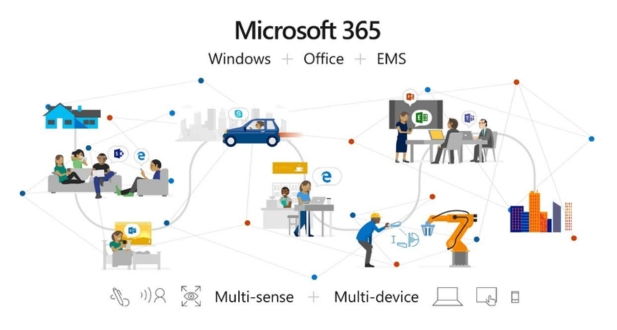Introduction
In today’s dynamic business environment, selecting the right productivity suite is crucial for seamless collaboration, efficient communication, and overall organizational success. Microsoft 365 has emerged as a leading solution, offering a comprehensive set of tools and services designed to enhance productivity and streamline business processes. However, with a range of plans available, choosing the right Microsoft 365 plan for your organization can be a complex decision. This guide aims to provide a thorough analysis of the various Microsoft 365 plans, helping you make an informed choice based on your specific requirements. In the contemporary business landscape, the choice of a productivity suite is pivotal for organizations aiming to foster seamless collaboration, enhance communication efficiency, and achieve overall success. Microsoft 365 has positioned itself as a forefront solution, presenting a robust array of tools and services tailored to boost productivity and streamline diverse business processes. However, given the assortment of plans offered by Microsoft 365, the decision-making process becomes intricate. This guide is crafted with the intention of conducting a comprehensive analysis of the diverse Microsoft 365 plans, empowering organizations to make informed choices aligned with their specific needs.
Understanding Microsoft 365
Before delving into the intricacies of the different plans, it’s essential to grasp the fundamental components that constitute Microsoft 365. Formerly recognized as Office 365, Microsoft 365 is not merely a suite of traditional Microsoft Office applications but a comprehensive cloud-based subscription service. This service seamlessly integrates conventional Office tools with an array of cloud-based platforms and services, creating a holistic solution for modern workplaces.
The core applications within Microsoft 365 span beyond the familiar Word, Excel, and PowerPoint. The suite includes collaborative platforms like SharePoint and Teams, fostering a collaborative environment where teams can work cohesively. Communication tools such as Outlook are seamlessly integrated, ensuring efficient and streamlined interaction among team members. Additionally, the inclusion of cloud storage through OneDrive adds a layer of accessibility and flexibility to data management.
Microsoft 365, at its essence, is tailored to meet the demands of the contemporary workplace. Whether teams are co-located in the same office or distributed across various locations, the service provides a unified and adaptable framework. Its cloud-based nature allows for enhanced flexibility and scalability, adapting to the dynamic needs of businesses in an ever-evolving digital landscape.
As organizations increasingly shift towards remote and collaborative work models, Microsoft 365 emerges as a strategic ally. Its multifaceted features not only cater to the traditional office suite requirements but also address the demand for collaborative, cloud-centric solutions. The seamless integration of various tools and services makes Microsoft 365 a comprehensive choice for businesses seeking a modern, efficient, and adaptable workplace solution.
Evaluating Your Business Needs for Microsoft 365 Plans

Before committing to a specific Microsoft 365 plan, a thorough assessment of your organization’s unique requirements is essential. Several factors should be carefully considered to ensure that the chosen plan aligns with your business objectives and operational demands.
Size of Your Organization:
The first consideration is the size of your organization. Microsoft 365 plans are often structured to accommodate different user bases, ranging from small businesses to large enterprises. Understanding the number of users in your organization is fundamental in selecting an appropriately sized plan that optimally supports your workforce.
Collaboration Requirements:
Effective collaboration is a cornerstone of modern business operations. Assess the collaboration needs within your organization to determine the essential features required. Microsoft 365 offers powerful collaboration tools like Microsoft Teams and SharePoint. If your teams heavily rely on collaborative projects, these features become crucial in fostering seamless teamwork.
Security and Compliance:
Security is a paramount concern for businesses, especially considering industry-specific regulations and compliance standards. Microsoft 365 provides a range of security tools, including Advanced Threat Protection and Information Rights Management. Evaluate your industry’s security and compliance requirements to ensure that the chosen plan includes features necessary to safeguard sensitive data and meet regulatory obligations.
Email and Communication Needs:
Email remains a foundational communication tool for businesses. Assess your organization’s email requirements, including storage capacity, archiving capabilities, and security features. Microsoft 365 offers robust email solutions, and understanding your communication needs will guide you in selecting a plan that meets your specific email requirements.
Mobility:
In an era where remote work and on-the-go productivity are increasingly prevalent, the mobility features of a Microsoft 365 plan are crucial. Consider how frequently your employees work remotely or on mobile devices. Ensure that the selected plan provides adequate support for mobile access and includes essential device management features to maintain productivity and security for employees working outside the traditional office environment.
Decision-Making Factors for Choosing Microsoft 365 Plans:

To make an informed decision about selecting the right Microsoft 365 plan for your organization, several key factors should be carefully considered.
Budget:
The budget is a crucial factor in determining which Microsoft 365 plan aligns with your financial constraints. The available plans cater to a diverse range of budgets. While some businesses may benefit from the advanced features of enterprise plans, others may find that a business or basic plan meets their needs at a more affordable price point. It’s essential to strike a balance between features and cost to ensure the optimal fit for your organization’s financial landscape.
Feature Requirements:
Each Microsoft 365 plan comes with its set of features. It is imperative to assess these features and align them with your organization’s specific needs. If collaboration and communication are top priorities, plans incorporating tools like Microsoft Teams and SharePoint are essential. Alternatively, if your organization deals with sensitive data, plans offering advanced security and compliance features should be considered. Understanding your feature requirements ensures that the selected plan enhances operational efficiency and productivity.
Scalability:
As businesses grow, their software and service needs evolve. Microsoft 365 plans often offer scalability, allowing organizations to easily add or remove users according to their requirements. When choosing a plan, it’s crucial to evaluate its flexibility in accommodating your organization’s future growth. This ensures that the chosen solution remains viable and cost-effective as your business expands.
Integration with Existing Systems:
The seamless integration of Microsoft 365 with your existing systems and workflows is essential for maximizing productivity. Microsoft products are designed to work cohesively with each other, but it’s equally important to ensure compatibility with any third-party applications your organization relies on. A thorough evaluation of integration capabilities helps avoid disruptions and enhances the overall efficiency of your business processes.
Support and Training:
Effective support and training are vital components of a successful Microsoft 365 implementation. Microsoft offers various support options, including online resources, forums, and direct assistance. When choosing a plan, it’s crucial to consider the level of support and training provided. This is particularly important if your organization is transitioning from another platform or if you anticipate a learning curve for your staff. Adequate support ensures a smooth adoption process and ongoing assistance when needed.
Assessing Business Requirements:
Size and Structure of Your Organization:
The size and structure of an organization play a pivotal role in determining the most suitable plan within Microsoft 365. For smaller businesses, cost-effectiveness and simplicity may be primary concerns. A streamlined suite that includes essential productivity tools might be preferable. On the other hand, large enterprises often require more complex solutions to accommodate a higher number of users and diverse business functions. Scalability, robust security features, and advanced collaboration tools become critical considerations for larger organizations.
Industry-Specific Requirements:
Industry-specific requirements are crucial factors in the selection of a Microsoft 365 plan. Various industries, such as healthcare and finance, have unique compliance and data protection needs. Microsoft 365 offers specialized plans that address these concerns, providing tools and features designed to meet industry regulations. Organizations operating in highly regulated sectors must prioritize plans that ensure compliance, safeguard sensitive data, and offer tailored solutions to industry-specific challenges.
Collaboration and Communication Needs:
The collaboration and communication tools within Microsoft 365 are diverse, offering a range of features that cater to different organizational needs. Assessing these tools in alignment with the specific requirements of the organization is paramount. For instance, organizations with a heavy emphasis on teamwork may prioritize plans that include advanced collaboration features like Teams and SharePoint. Communication needs, whether they involve internal discussions or client interactions, should be matched with the capabilities of Microsoft 365’s communication tools, ensuring seamless and efficient operations.
By meticulously evaluating these aspects, organizations can align their business requirements with the features and capabilities offered by Microsoft 365, making an informed decision that optimally serves their unique needs.
Features and Applications
Core Productivity Apps:
The core productivity apps within the suite play a pivotal role in shaping the user experience. Microsoft Office includes essential applications such as Word, Excel, PowerPoint, and Outlook. One crucial aspect to consider across plans is the variation in features and capabilities of these applications. It is important to assess whether the plans differ in terms of functionalities provided by these applications. Additionally, the inclusion of desktop versions versus web-based applications can significantly impact user accessibility and collaboration. Understanding these distinctions is key to choosing a plan that aligns with the specific needs and preferences of the users within an organization.
Collaboration Tools:
Collaboration tools are fundamental for modern workplaces, and Microsoft 365 offers a suite of applications designed to enhance teamwork. SharePoint, Teams, and Yammer are integral components, each serving unique purposes in fostering collaboration. Evaluating these tools involves understanding their individual strengths and assessing the level of collaboration required within an organization. Teams, for instance, is a hub for real-time collaboration, while SharePoint is more focused on document management and storage. Determining the specific collaboration needs of an organization helps in selecting the right plan that optimally supports teamwork and communication.
Security and Compliance:
Security and compliance are paramount considerations for organizations, particularly in industries with stringent regulatory requirements. Microsoft 365 provides a range of security features, including threat protection, data loss prevention, and identity management. It is crucial to examine the nuances of these security features across plans to ensure that the chosen subscription aligns with the organization’s security requirements. Moreover, compliance features play a vital role, especially for businesses operating in regulated industries. Understanding the compliance capabilities of each plan and their significance in maintaining regulatory standards is essential for making an informed decision on the most suitable Microsoft 365 subscription for a particular organization.
Pricing and Licensing Models for Microsoft 365:

Pricing Structures:
Microsoft 365 offers a variety of plans catering to different user needs, and understanding the pricing structures is crucial for businesses. A key consideration is the choice between monthly and annual subscriptions. Monthly plans provide flexibility, allowing organizations to scale up or down as needed without a long-term commitment. On the other hand, annual subscriptions often come with cost savings, providing a more economical option for organizations with stable user requirements.
In-depth analysis of the pricing models should also involve an exploration of any hidden costs or additional fees associated with specific plans. This includes understanding the costs related to additional features, storage, or user thresholds that might not be immediately apparent. A transparent understanding of the pricing structure ensures that organizations can make informed decisions that align with their budgetary constraints.
Licensing Considerations:
Microsoft 365 employs user-based licensing and device-based licensing, each with its own implications. User-based licensing is tied to individual users, allowing flexibility as users can access their accounts from multiple devices. However, it is essential to understand the potential challenges related to user turnover and ensuring compliance with licensing terms.
Device-based licensing options are also available, and understanding their relevance to the organization is crucial. This model ties the license to a specific device, which can be beneficial for shared workstations. Organizations need to evaluate their work environment and user patterns to determine the most cost-effective and operationally efficient licensing approach.
Scalability and Flexibility:
Scalability is a critical factor in choosing a Microsoft 365 plan. Organizations should evaluate how well each plan can adapt to the changing needs of their business. This involves considering factors such as the ease of adding or removing users, upgrading plans, and adjusting resources based on demand.
Flexibility is closely tied to scalability, emphasizing the importance of choosing a plan that can accommodate both current and future requirements. A flexible licensing model allows organizations to pivot and adjust to evolving business landscapes, ensuring that the chosen Microsoft 365 plan remains an asset rather than a limitation. Careful consideration of scalability and flexibility is essential for long-term sustainability and cost-effectiveness.
Integration with Third-Party Apps and Services
Compatibility with Existing Systems:
In the realm of IT infrastructure, the compatibility of Microsoft 365 with the existing systems is a critical consideration. A thorough assessment is necessary to ensure a smooth integration process. This involves evaluating the current hardware, software, and network configurations within the organization. The goal is to identify potential points of friction and compatibility issues that might arise during the integration of Microsoft 365. Additionally, it is crucial to examine whether the existing security protocols align with the security features offered by Microsoft 365, ensuring a robust and cohesive IT environment.
Potential integration challenges may include data migration complexities, security protocol disparities, or application dependencies. Addressing these challenges requires strategic planning and the implementation of suitable solutions. This could involve updating or modifying the existing infrastructure to meet the requirements of Microsoft 365 or adopting transitional measures to bridge any technological gaps. Communication and collaboration among IT teams are essential to foresee and overcome these challenges, ensuring a successful integration without disrupting day-to-day operations.
Third-Party App Integration:
Microsoft 365’s effectiveness often depends on its ability to seamlessly integrate with third-party applications and services. In this section, it is imperative to explore the compatibility and integration options available. The evaluation should encompass a wide range of third-party applications that the organization currently employs or anticipates using in the future. Assessing the availability of Application Programming Interfaces (APIs) and connectors becomes crucial in determining the ease of integration.
Understanding the landscape of third-party applications and services that can integrate with Microsoft 365 adds a layer of flexibility and scalability to the organization’s digital ecosystem. It enables the creation of a cohesive environment where data flows seamlessly between Microsoft 365 and other tools, optimizing workflow and enhancing overall productivity. The discussion should delve into specific examples of third-party applications commonly used in the industry and how Microsoft 365 can be configured to work harmoniously with them.
A comprehensive exploration of compatibility and integration aspects with both existing systems and third-party applications is fundamental in realizing the full potential of Microsoft 365 within an organizational context. This evaluation lays the groundwork for a streamlined, efficient, and interconnected digital infrastructure.
Support and Service Level Agreements (SLAs)
Customer Support:
Customer support is a critical aspect to consider when evaluating any service, including Microsoft 365 plans. It encompasses the various avenues through which users can seek assistance, such as live chat, email, phone support, or online forums. Responsive and effective customer support is essential, particularly in the context of technical issues that users may encounter during their usage of Microsoft 365. Quick and accurate resolution of problems can significantly impact user satisfaction and productivity.
Different Microsoft 365 plans may offer varying levels of customer support. It’s important to examine the support options provided with each plan and assess their alignment with the organization’s needs. Factors to consider include the availability of 24/7 support, the expertise of support staff, and the accessibility of support channels. A comprehensive customer support infrastructure ensures that users have the necessary assistance whenever they face challenges, contributing to a positive overall experience with the Microsoft 365 platform.
Service Level Agreements (SLAs):
Service Level Agreements (SLAs) are contractual commitments that define the expected performance and reliability of a service. In the context of Microsoft 365 plans, it’s crucial to understand the SLAs associated with each plan to evaluate the reliability and availability of the services provided. SLAs typically include parameters such as uptime guarantees and service response times.
Uptime guarantees specify the percentage of time during which the service is expected to be operational. For instance, a 99.9% uptime guarantee implies that the service should be available for use 99.9% of the time. Evaluating these guarantees is essential, especially for organizations with critical and time-sensitive operations that heavily rely on Microsoft 365.
Service response times outline the duration within which the service provider commits to addressing and resolving issues. Faster response times contribute to minimizing downtime and maintaining seamless operations. Understanding these commitments is crucial for organizations to manage expectations and plan their activities effectively.
A thorough examination of customer support options and SLAs associated with Microsoft 365 plans is essential for organizations seeking a reliable and well-supported cloud productivity solution. These considerations contribute significantly to the overall satisfaction and success of users relying on Microsoft 365 services.
Conclusion:
Selecting the right Microsoft 365 plan for your business involves a thorough understanding of your organization’s unique needs, coupled with a detailed analysis of the features, pricing, and support options provided by each plan. By considering factors such as organization size, industry requirements, collaboration needs, and security features, you can make an informed decision that aligns with your business goals and ensures optimal productivity and efficiency.
In this guide, we have covered the key aspects to consider when choosing a Microsoft 365 plan, providing a roadmap for businesses to navigate the complexities of plan selection. As technology continues to advance, staying abreast of Microsoft 365 updates and new features will be essential for maximizing the benefits of this powerful suite of tools.
Consider factors such as the size of your organization, specific business needs, security requirements, and the level of functionality required for your users.
Assess the number of users who will require access to Microsoft 365 services. Most plans are licensed per user, so understanding your user base is crucial.
Microsoft 365 Business is designed for small to medium-sized businesses, while Enterprise plans cater to larger organizations with more advanced security and compliance needs. Enterprises plans often include more advanced features.
Yes, Microsoft offers plans tailored for specific industries such as education and government. These plans include features and compliance tools specific to the needs of those sectors.
Security and compliance features vary across plans. Consider the sensitivity of your data and compliance requirements when choosing a plan. Enterprise plans typically offer more robust security features.
Yes, Microsoft allows you to mix and match plans based on user needs. This flexibility enables you to provide the right set of tools for different roles within your organization.
Microsoft 365 includes tools like Teams, SharePoint, and OneDrive for Business to facilitate collaboration. Check the specific plan to ensure it meets your collaboration needs.
Yes, most plans include access to desktop versions of Microsoft Office applications. Ensure that the plan you choose provides the necessary applications for your users.
Microsoft provides regular updates for its 365 services. Support options vary based on the plan, with Enterprise plans typically offering more extensive support options, including 24/7 support.








